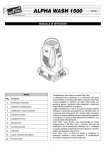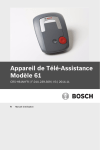Download FirstCall User Guide Ver3 Nov 2013
Transcript
® User Guide If this equipment does not make a call to the Monitoring Service when activated, or if help does not arrive as expected, use another method to get help. Please ensure that you test the equipment regularly, by making test-calls through to your responders. FirstCall Medical Alarms can be connected to the National Broadband Network (NBN) UNI-V connection. Tell anyone who contacts you about the NBN that you have a FirstCall Medical Alarm and that you require a battery back-up power supply. For more information see the FirstCall website at: www.firstcallmedicalalarms.com.au 1 Table of Contents Introduction Life Support Policy Choosing Your Responders Installing FirstCall Testing FirstCall Operation Pendant and Watch Triggers Making an Emergency call How to Cancel an alarm Answering a Phone Call with the Pendant/Watch Voice warning messages The Lights Warning Lights Mode-3 telephone Connection ADSL Filters Questions & Answers Notices Warranty Connecting Through a PABX Additional Equipment 3 4 5 6 11 13 14 15 15 16 17 18-20 21 21 22-24 25-26 27 28 29 2 ... u o y k n a Th …for choosing FirstCall. We believe this equipment will help you to live independently in the safety and security of your own home. FirstCall consists of a Pendant/Watch and an Alarm Unit which is connected to the telephone line and a power point. When the HELP button on the pendant/watch or the Alarm Unit is pressed, the Alarm Unit will call your family and friends and automatically play them a voice message requesting help. Your family and friends will know who you are and that you need help, and they may also speak to you through the loudspeaker in the Alarm Unit. It is not essential for them to speak to you, but if they can they can find out the nature of the problem and reassure you that help is on the way. This equipment is designed and manufactured in Australia by VC International Pty. Ltd. (VCi), a design and manufacturing company which benefits from over 30 years experience. FirstCall should give many years of trouble free service, however, there are things you need to know about the operation, testing and potential limitations of the equipment. Please read this manual carefully, including the Notices section. 3 Life Support Policy The FirstCall Alarm System enables caregivers to provide an effective response system. However, the Alarm System is not a life saving device and cannot provide a guaranteed level of performance beyond what can be expected from technology of this kind. The manufacturers of the Alarm System design equipment and systems of high performance and reliability. The Alarm System employs extensive self-testing and error checking techniques that minimise the risk of false or missed calls. While the equipment is inherently reliable, it can only perform it’s function when operated correctly. It is essential that the user develops operating procedures which include regular system testing and consideration of other forms of communication to call for assistance in the unlikely event that a malfunction occurs. To ensure that the system performs as designed, it must be installed, operated, maintained, and regularly tested in accordance with the information contained in this Guide and other supporting documentation. The user has the sole responsibility for maintaining and testing of the alarm. Use of the FirstCall Alarm is acknowledgement that you understand and agree to these conditions. If you do not agree to these conditions please return the alarm equipment to FirstCall Medical Alarms at the address shown at the back of this manual, within 30 days of equipment purchase, for a refund of all money paid less delivery charges. 4 Choosing Your Responders You can choose who takes your calls depending on your needs. Your calls for assistance can go directly to your family and friends, thus avoiding any on-going fees. FirstCall can also be configured to send all your calls to a professional 24-hour alarm monitoring service. We can arrange this service for you either at the time of purchase or at any time after. Several days notice is required for changing from family and friends to the 24-hour monitoring Option. If you choose to have your family and friends take your calls, you should have at least three people who are willing and able to take those calls, 24-hours a day, every day of the year. You need to choose those people very carefully. Your Responders should have some way of gaining access to your property. FirstCall can supply a combination lock and key holder for that purpose which can be attached to a secure fixing point in your property. Using family and friends to take calls for assistance is not suitable for everyone, so if you do not have at least three people who are in constant land-line or mobile phone contact, or your health condition warrants it, you should consider using a professional 24-hour Monitoring Service instead. Additional information about the 24/7 Monitoring Service is available from FirstCall. 5 How to Install Your FirstCall The following steps describe how to install and test your FirstCall. Unpack the Alarm You should have: ● One Alarm Unit ● One pendant/watch ● One telephone line adaptor connected to the telephone lead* * supplied connected to the Alarm Unit. Before installing FirstCall, please see the sections ‘ADSL filters’ and ‘Mode-3 connections’ in this manual. Find a Good Location for the Alarm Unit The Alarm Unit should be located next to a power point and a telephone socket, and if possible close to where you spend a lot of time. A living area or bedroom is always a good choice. 6 Plug into the Power Plug in the power transformer and turn on the power-point. Check the green light on the power transformer comes on. If the green light does not come on please check the power point is working by plugging in another appliance or a light. Green Light Double adaptors and power boards should be avoided as they can be unreliable. Extension cords can be used but position them carefully so they do not become a trip hazard. Plug-in the Telephone Connection The Alarm Unit can be plugged into new-style or old-style telephone sockets. The following pages describe how to connect the Alarm Unit to new and old style telephone wall sockets, and how to then re-connect your telephone. New style RJ-11 telephone socket 7 Old style 610 telephone socket If your home has a new style telephone socket Continued…. Connect the Alarm Unit to the telephone line socket with the supplied telephone lead Connect the phone to this socket only New style phone socket Refer to the diagram above. Remove the telephone adaptor plug and plug the alarms telephone lead into the new-style wall socket. Plug the other end of the telephone lead into the socket on the rear of the Alarm Unit as shown. The telephone lead is usually supplied already be connected to the alarm. Plug your house telephone into the socket on the rear of the Alarm Unit as shown. This socket may be masked-off with a plastic cover which must be removed. Pick-up your telephone handset and check for dial-tone. If you cannot hear dial-tone recheck all the connections. 8 If your home has an old-style phone socket Continued…. Adapter plug Remove the house telephones lead from the wall socket and plug-in the large adaptor plug. Plug the house telephone lead into the rear of the adaptor plug as shown in the diagram. Old-style wall socket Telephone lead to house telephone Telephone lead to Alarm Unit Pick-up your telephone handset and check for dial-tone. If you cannot hear dial tone recheck all the connections. Unwrap the Radio Antenna The loose wire from the rear of the Alarm Unit is the radio antenna. Stretch it out to it’s full length and let it hang out behind the Alarm Unit. 9 Switch On the Alarm Unit Switch-on the power on the rear of the Alarm Unit and check the lights flash on the front panel. Power switch (Down is on) If the lights do not flash, or if a light remains flashing yellow or red, check the transformer is fully pushed into the power-point and the power point is switched on. The blue light may remain flashing for up to one minute. If after one minute the blue light is still flashing check the telephone lead connections. If you have fixed the problem, the blue light will stop flashing within one minute. Multi-colour Flashing light Yellow light Red light Blue light The yellow light will remain on until you operate the pendant or watch for the first time. Important: Test FirstCall through to your responders after installation or relocation, or if the leads have been changed. 10 Testing FirstCall Let Your Responders Know You’re Testing It’s important to tell your responders you are about to test your FirstCall, otherwise they may think you need help. It’s a good idea to have your responders present when FirstCall is tested for the first time, so they can see how it works too. Make sure your responders have received the information sheet- Advice for FirstCall Responders. If you have elected to have your calls answered by a 24-hour Monitoring Service, telephone the Monitoring Service now and follow their directions. Check the Range of the Pendant or Watch To check the range of the pendant/watch, have one person standing by the Alarm Unit ready to push the cancel button, while a second person operates the pendant/watch from various locations around the home and garden. Each time the alarm sounds push the cancel button to stop the alarm. To give a margin of safety, do not rely on more than half the actual range found during this test. 11 Making a Call to Your Responders FirstCall comes pre-programmed with the Responder’s telephone numbers previously supplied to us, and your personal voice message. Press the pendant/watch for a few seconds to activate the FirstCall. This time do not press the Cancel button. FirstCall will now make calls to your responders. When your Responders answer they will hear the voice message, and they may also be able to speak to you over the loudspeaker in the Alarm Unit. Please do not pick up the telephone. FirstCall will continue to make calls until one or two calls (depending on your instructions) have been answered and correctly acknowledged. ations! Congratul You have now successfully installed and tested your FirstCall. Please wear your pendant/watch whenever you are at home or in your garden. Please test your FirstCall alarm regularly. We recommend testing about every two weeks. 12 Pendant and Watch Triggers When pressed, the pendant/watch activates the FirstCall alarm. The red light shows that the pendant/watch button has been activated and a signal is being sent to the FirstCall alarm unit. The pendant/watch will normally work from around the home and garden. Please see the information regarding the pendant/watch range in the Notices Section. The pendant/watch is waterproof to International Environmental Protection Standard IP-67, but if you wear it in the bath or shower please be certain to very regularly check its operation. Please do not leave the pendant/watch in the soap holder. The internal battery should last for many years. If the internal battery is getting low, the yellow light on the front of the Alarm Unit will flash, (see the section The lights on the Alarm Unit). Contact FirstCall for a replacement pendant. Note: Watch triggers should be used with caution as an event which incapacitates a users other hand will make it impossible to activate activate the watch. A pendant can be activated by both hands. 13 Making an Emergency Call To make an emergency call, press the pendant/watch or the HELP button on the Alarm Unit. Press the red button firmly for a few seconds and you will hear the alarm sound from the FirstCall loudspeaker, and a red light will come on. After about 10 seconds the Alarm Unit will start to call your responders. You will hear FirstCall calling to your first responder, and then you will hear the emergency voice message. After a short time you may be able to speak with your Responder over FirstCall’s loudspeaker. Remember it is not necessary for your Responder to speak with you. They will hear the voice message, so they will know that you need help. The Alarm Unit will continue to call your Responders until the calls* have been answered and correctly acknowledged. The Alarm Unit will then automatically reset, ready to use again. * FirstCall can be set to require either one or two calls to be answered and acknowledged. 14 How to Cancel the Alarm Press the Cancel button to stop FirstCall making calls. However a call can only be cancelled while the alarm is sounding, and only before FirstCall starts to dial the first number. Answering a Phone Call with the Pendant/Watch (This function can be confusing and is not suitable for everyone) You can answer a telephone call using the pendant/watch, and hold a ‘hands-free’ telephone conversation through the loudspeaker in the FirstCall alarm. To answer a call, press the pendant/watch while the telephone is ringing. You can pick-up the telephone handset at any time during a ‘hands-free’ call to change from ‘hands-free’ to a ‘private’ telephone handset call. To hang-up the call, press the pendant/watch again, or pick-up and replace the telephone handset. Note: If you need to use your alarm during a hands-free telephone call you will need to press the pendant twice, with each press at least 4 seconds apart. 15 Voice Warning Messages “The power is disconnected…. please check the power” The FirstCall alarm will play voice messages from its loudspeaker if the mains power has been disconnected for more than 4 Hours. Firstcall will also notify your responders if the mains power remains disconnected for more than about 6 hours. “The Firstcall does not have a working telephone line” FirstCall also plays warning messages if the telephone line is disconnected. Firstcall cannot make a call if the telephone line is faulty, so responders will not be notified about telephone line faults. Warning messages are repeated every 4 hours but, to avoid inconvenience, are not made late at night. How to Cancel Voice Warning Messages To stop voice warning messages press the yellow OK button. OK 16 The Lights The Flashing Power Status Light The Blinking Yellow Pendant Battery Light The Red Call Activated Light The Blue Telephone Line Light The lights on the front of the FirstCall alarm show the operational status of the equipment, and if a problem has been detected. The following pages describe what the warning lights mean, and suggest a few things to try to solve a problem. There are some faults which FirstCall cannot detect. The lights are not a substitute for regular testing. 17 Warning lights The Flashing Power Status Light This light checks the power to the FirstCall Alarm Unit Flashing Green OK - Everything is normal Problem - The mains power is switched OFF or is disconnected. Flashing Yellow OR Flashing Red No Flashing Light Check 1. The power transformer is pressed hard into the power point and the power is switched ON. 2. The green light on the FirstCall power transformer is on. If the green light is not lit the problem may be with the power point or the house power. Use another appliance to check the power point. Problem - The equipment is not working ! Check - FirstCall is switched on at the small recessed switch on the rear panel. Also check items 1 and 2 above. If the Power Status Light is still not flashing green call FirstCall for assistance. 18 Warning Lights, continued… The Blue Telephone Line Light This light checks the status of the telephone line No Blue Light OK - Everything is normal Steady Blue Light OK - A Mode-3 connected telephone is off-the-hook or in-use. Problem - The telephone line is disconnected and FirstCall cannot make a call. Check 1. That all telephone plugs are fully pressed into their sockets. Flashing Blue Light 19 2. Check for dial-tone on the telephone. If you DO NOT hear dial tone, unplug the Alarm Unit from the telephone wall socket and plug the house telephone directly into the telephone wall socket, i.e. how it was prior to installing the alarm. If you now DO hear dial-tone, the fault may be with the Alarm Unit. Contact FirstCall for assistance. Your telephone company may charge a call-out fee if they are called and no fault is found with the telephone line. Warning Lights, continued… The Yellow Pendant/Watch Light No Yellow Light All OK Note: The yellow light will remain on until you operate the pendant or watch for the first time. If the power fails and the battery runs flat, the yellow light will come on again when power is restored until the pendant or watch has been tested again.. Problem - The pendant/watch battery is getting low Blinking Yellow Light The battery in the pendant or watch should last for many years, however if the pendant or watch has been operated with a low battery the Yellow Light will blink once every 5 seconds. The pendant/watch battery is tested each time you test or use your alarm - you must operate the pendant/watch for the battery to be tested. If this light blinks contact FirstCall for a replacement pendant. The light will continue to blink until a new pendant/watch with a fresh battery is operated with the alarm. 20 Mode-3 Telephone Connection A Mode-3 telephone connection is a way of wiring a telephone line so FirstCall will still work if any extension telephones are left off-the-hook. If you have more than one telephone, or any other telephone equipment such as a dial-up modem or a FAX, we recommend that the telephone line is wired in Mode-3. Contact your telephone company for more information. Your telephone company will charge for this work. Note: A Mode-3 connection is not required if only ‘cordless’ phones are used, and if the base station is connected to the rear of the Alarm Unit or to the FirstCall telephone adaptor plug. Important: If you do not have a Mode-3 connection the alarm will not work if any extension telephones, or any other equipment such as FAX machines or dial-up modems, are off-hook or in-use. ADSL Filters If you have the internet connected you may have an ADSL service. If you have ADSL you will need to connect an ADSL filter to stop the ADSL signal from interfering with the FirstCall alarm. The filter will remove the ADSL signal from the FirstCall and any telephones connected to the rear of FirstCall or the Adaptor plug. 21 To telephone wall socket Connect ADSL filter in the Alarm Unit telephone cord The filter will also remove the ADSL from any telephone sockets that have been wired in Mode-3. Important: If an ADSL filter is not installed when required, the alarm may not work. Questions and Answers Q Should FirstCall be tested? A Yes. You should test FirstCall regularly. Q Can FirstCall be installed with more than one telephone? A Yes, but see the important information in the section ‘Mode-3 Telephone Connection’. Q What happens if the power fails, or during a black-out? A The alarm unit will run for up to 70 hours on its internal battery. If the NBN is connected, a battery back-up power supply must be provided for all NBN customer equipment. Even then, the NBN will only work for a few hours during a power failure. Q What if I set my alarm off by accident? A FirstCall can be cancelled while the alarm is sounding by pressing the CANCEL button on the Alarm Unit. Q I am changing my telephone company. Will this affect the Alarm? A Not normally. If you are keeping your existing telephone line it should not affect the alarm. Q What distance will the pendant/watch operate over? A In most situations, anywhere around the home and in the garden. The pendant/watch range will vary depending on the type of construction of the building and other environmental factors. The range should be tested as described in the Testing section. Also see the ‘Notices’ section in this manual. 22 Questions and answers continued …. Q Can I use FirstCall in an electrical storm? A Yes, unlike your telephone, there is no danger in using the pendant/watch to call for help during an electrical storm. However, avoid touching the wires or the FirstCall Alarm Unit. Only use the pendant/watch. After a severe storm it is always a good idea to test the telephone for dial-tone and also test the alarm. See ‘Testing’ in this manual. Q What happens if the telephone line is disconnected? A FirstCall cannot work without a working telephone line. The blue light will flash if the telephone line is cut and will extinguish after it is re-connected. There are other telephone line faults which cannot be detected. See the ‘Notices’ section in this manual. Q Will the pendant/watch battery ever need replacing? A Not normally. The battery is designed to last for many years, even if the pendant/watch is used every day. The battery is automatically tested every time the pendant/watch is pressed. If the red “Call Activated” light on the front of the FirstCall is flashing, the pendant/watch battery is getting low and you need a new pendant/watch. See section - The Lights on the FirstCall Unit. Contact FirstCall for a new pendant or watch. Q What should I do with the pendant or watch when I’m in the bath or shower? A The pendant and watch are designed to be waterproof to International Environmental Protection Standard IP-67, so they can be taken into the shower or bath. However, make sure you test the pendant/watch very regularly and do not leave the pendant/watch in the soap holder. 23 Questions and answers continued …. Q Will the alarm still work with the internet (also known as ADSL, DSL or broadband) connected to my telephone line? A Yes, but if you have an ADSL service, you must have an ADSL filter connected in the telephone lead to the FirstCall alarm. See the section on ‘ADSL filters’. Q My telephone service is going to be changed to a wireless, cable, or Internet service. Will this affect my FirstCall? A It may. Call FirstCall for assistance. Q The NBN is being installed in my area. Will this affect my medical alarm? A The FirstCall Medical Alarm has been tested and works correctly when connected to the NBN service through via the UNI-V (Voice ports) or via an ATA connected to the UNI-D (Data ports). An NBN battery back-up power supply must be installed, and even then the NBN will only work for a few hours during a power failure. Tell everyone installing your NBN service that you have a FirstCall medical Alarm. Please see www.firstcallmedicalalarms.com.au for the latest information about the NBN. Q How do I clean the equipment? A Use a mild detergent on a damp cloth. Do not use harsh detergents or chemicals, or too much soap or water. 24 Notices Telephone Network Performance This equipment makes telephone calls in order to summon help. If unsuccessful, the equipment will continue making calls to the maximum number of call attempts allowed by Government telecommunication regulation. Although modern telephone networks are very reliable, there are times when, due to network congestion, fault conditions or other causes beyond our control, the telephone calls may not be successful. Portable (cordless) Phones Some portable phones (DECT) may interfere with the Alarm Unit and may reduce the range of the pendant/watch. The base unit for DECT cordless portable phones should be placed at least 300 mm away from the FirstCall Unit and the range of the pendant/watch should be determined after installing the portable phone system. Extension Telephones or Other Telephone Equipment If there are other pieces of equipment on the telephone line such as extension phones, fax machines, modems, answering machines, or any other device, the telephone line should be wired in Mode-3. If the telephone line is not wired in Mode-3, an emergency call will not be made if any other telephone equipment is left off-hook, or is in use. We advise the telephone line is wired in Mode-3 by a suitably qualified person. The equipment will also work in Mode-5. 25 Notices continued…. Range of Trigger Devices In most cases the pendant/watch will operate around an average size home and garden, however radio range can vary greatly depending on environmental and other factors. It is very important that the radio range be determined at the time of installation by testing the pendant/watch as described in this manual. To provide a margin of safety, do not rely on more than half of the radio range found during that test. Moisture The Alarm Unit is resistant to accidental spillage on its top surface only. The pendant and watch is designed to be waterproof to International Environmental Protection Standard IP-67. Do not put the pendant/watch into a washing machine or leave immersed for long periods. Do not leave the pendant/watch in damp locations for long periods. Do not leave the pendant/watch in a soap holder. Trade Marks FirstCall, Gemini, Companion, The Caretaker, CarePhone, Life Alert, Life Assist, Safeguard, Xtracare from Safeguard, and Viconic are registered trademarks. 26 Warranty Information The manufacturer of the FirstCall equipment, VC International Pty Ltd (VCI), guarantees the product to be free from defects in materials and/or faulty workmanship for a period of 12 months, subject to the following conditions. The warranty is effective from the date of original purchase from FirstCall Connect Pty Ltd (FirstCall). No obligation will exist under this warranty if the customer cannot provide proof and date of original purchase. A record of payment is sufficient. VCI will perform repairs or effect replacement, at their option, with no cost to the purchaser other than shipping charges to and from the service facility. This warranty does not cover claims for normal wear and tear, improper use or neglect, electrical transient damage or fusion, battery replacement, acts of God, or when the equipment has been subjected to unauthorised alterations. There are no other warranties expressed or implied, including but not limited to the implied warranties of merchantability and fitness for a particular purpose, that apply to this product following the period of the express warranty provided by VCI. FirstCall and/or VCI shall not be liable for any special indirect incidental or consequential damages including but not limited to personal injury or death arising from any defect of the goods supplied. 27 Connecting Through a PABX To set FirstCall to work through a PABX, locate the small switches on the bottom of the Alarm Unit and set the PABX switch, as shown below. The PABX access digit dialled is 0. Other access digits can be programmed on request. PABX Access Switch To dial through a PABX set Switch 2 to ON. Note: FirstCall cannot be connected to a DIGITAL PABX system 28 Additional Equipment Watch ADSL Filter Wall Mounted Call Button Wireless Terminal Pendant Touch Pad or blow switch 29 FirstCall also supplies call-buttons for special needs. Call us on 1300 40 80 80 The FirstCall Medical Alarm is Designed and Manufactured in Australia by: VC International Pty Ltd Unit 26, 34-36 Abel Street PENRITH NSW 2750 www.vcint.com.au Regulatory Notices: Caution Warning For safety reasons, only connect approved telephone equipment to the rear terminal. This equipment has been tested to show compliance with the relevant regulations, which are designed to provide reasonable protection against electromagnetic interference. If this equipment causes interference due to localized environmental conditions, the user shall, at their own expense be required to take appropriate measures to correct the interference. No user serviceable parts are inside. Do not attempt to open the equipment. Do not cut any wires connecting the equipment. Disclaimer FirstCall Connect Pty Ltd has exercised its best efforts in relation to the information in this manual. However, no warranty of reliability or accuracy is given and VCi shall not be responsible for any error or omission (whether negligent or otherwise). This information may change without notice. TELEPERMIT 30 Your Responders For convenience, you can write the phone numbers of your responders in the table below. Phone Number Given Name 1 2 3 4 5 Please include STD code ( ) ( ) ( ) ( ) ( ) 31 FirstCall User Guide Rev 3.0










































